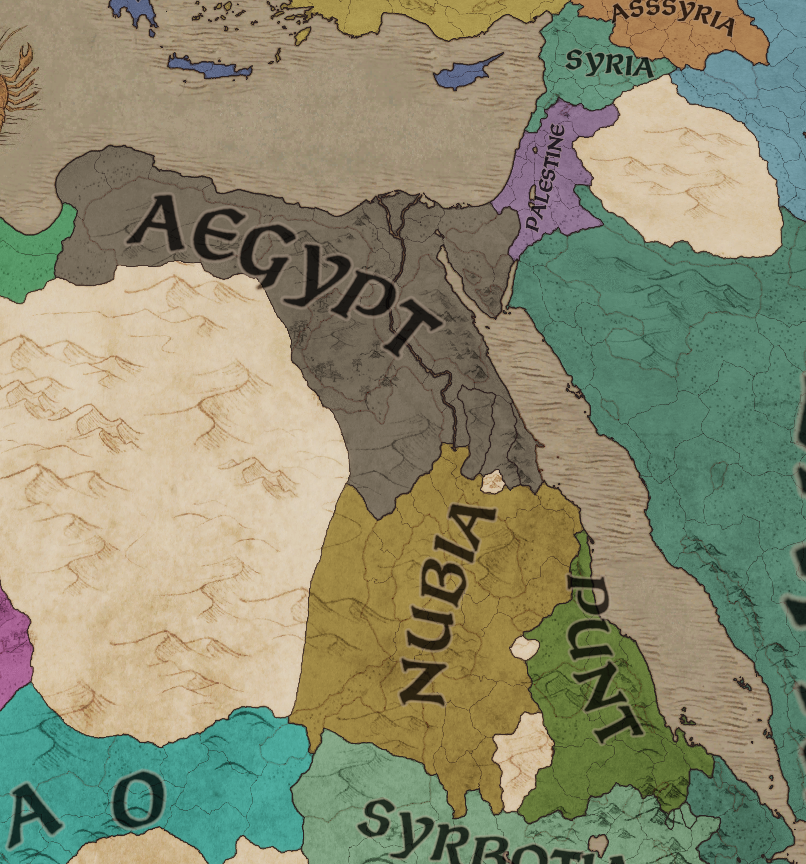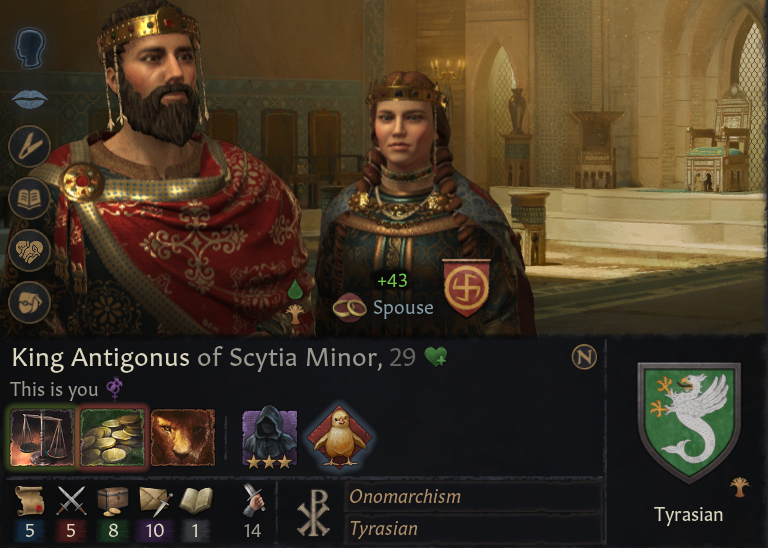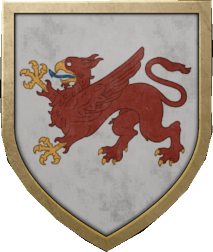The Known World (Part I) - 800 AD

The Known World (Part I) - 800 AD

North Africa – 800 AD
The reborn Carthaginian Empire, also known as Neo-Carthage, had its roots in the Kingdom of Massaesylia, which by 600 AD had united most of the North African Punic states. The kingdoms of Kirob and Arambys, historical rivals of Massaesylia, were conquered and annexed, allowing Massaesylia to transform into a new, powerful state called Carthage. Neo-Carthage was a syncretic state, blending elements of traditional Punic culture with Berber and Hellenistic influences. The Punic language remained the language of administration and the elite, though Berber dialects began to dominate in the south. The center of the new empire was the renewed Carthage, which once again became a powerful city, full of magnificent temples, palaces, and markets, rebuilt thanks to the wealth from new conquests. Under the rule of strong leaders, Neo-Carthage turned its attention to further expanding its borders. In the 7th century AD, the Carthaginians fought a series of wars with the Kingdom of Atlas. After prolonged and bloody campaigns, Carthage defeated Atlas, annexing its territories. This victory gave Carthage control over the entire northwestern African coast, enabling further expansion to the south.
One of Neo-Carthage’s most ambitious undertakings was the exploration and colonization of the Sahara and the slow reach into sub-Saharan Africa. Using both caravans and advanced irrigation techniques, the Carthaginians created a network of oases and trading forts that connected their empire with southern regions. Trade in gold, salt, slaves, and exotic goods from sub-Saharan Africa became one of Neo-Carthage’s main sources of income, strengthening its position in the region. Despite its successes in expansion, Carthage faced serious internal problems. By the end of the 7th century AD, rebellions broke out among the Christian inhabitants of Sardinia and Corsica, who rejected Punic rule and declared independence. These rebellions were supported by neighboring Christian kingdoms, which saw Carthage as a pagan empire. As a result of these events, Carthage lost control of Sardinia and Corsica, a severe blow to its prestige and influence in the western Mediterranean.

Iberian Peninsula – 800 AD
The Iberian Peninsula between 600 and 800 AD was a place of intense wars, political, and social transformations. Conflicts between the northern Ibero-Celtic kingdoms and the post-Carthaginian state of Baestania, as well as subsequent external invasions and internal strife, led to the emergence of new political structures on the peninsula. At the beginning of the 7th century, the kingdoms of Tritium and Tapolia, located in the northern Iberian Peninsula, began a series of wars with Baestania, a post-Carthaginian kingdom controlling the southern areas of the peninsula. Baestania, with a history dating back to the mid-4th century AD, was a powerful state that managed to survive and dominate the southern part of the peninsula. These wars were the result of rivalry for influence on the Iberian Peninsula and control over strategic trade routes and natural resources. The prolonged wars depleted the resources of Tritium, Tapolia, and Baestania, weakening their positions. As a result of these exhausting conflicts, the power of the kings weakened, leading to splits and the rise of new, independent political entities. Between 720 and 740 AD, the Duchy of Counei emerged on the western coast, and the Kingdom of Asturias in the northwestern part of the peninsula.
In the late 6th century, the Alameann Empire entered the Iberian Peninsula, and after a series of successful military campaigns, it subjugated the northwestern part of the region. During the early 7th century and throughout the 8th century, the Alameann Empire conducted a series of campaigns that led to the conquest of the Kingdom of Constetania. However, the Alameann rule on the Iberian Peninsula did not last long. Internal succession struggles and increasing resistance from local elites led the Alameann Empire to lose control over its possessions. Between 770 and 800 AD, the Kingdom of Urbiaca and the Kingdom of Tarraconessis emerged in the former Constetania, resulting from the collapse of Alameann control and local uprisings. Although these kingdoms were young, they quickly established themselves in the region, becoming new centers of power on the Iberian Peninsula.

British Isles – 800 AD
Between 600 and 800 AD, the British Isles experienced the consolidation of Celtic kingdoms. Through a series of wars, alliances, and dynastic reshuffles, strong political structures re-emerged. In Hibernia, the first half of the 7th century was marked by continuous wars between local kingdoms. At the beginning of this period, dominance was divided among several strong kingdoms, such as Ulaid, Connacht, and Mumu. The kings of these lands fought incessantly for influence, leading to the destabilization of the island. The turning point was the war between 670 and 690 AD, known as the War of the Two Crowns, which erupted between Connacht and Mumu. Both kingdoms fought for control over the central part of the island. The conflict ended with the decisive Battle of Mag Tuired (around 688 AD), where the King of Connacht achieved a crushing victory. This victory gave Connacht a significant advantage and began the process of consolidating the island. By 750 AD, the High Kingdom of Ivernia was proclaimed, covering most of the island’s territory.
In northern Britain, in Caledonia, the early 7th century was characterized by the decline of central power and the fragmentation of power among local chieftains. The Kingdom of Bremenium, which emerged from the ruins of earlier tribal structures, became the strongest state in the region after 650 AD. However, due to succession and dynastic disputes, Bremenium was divided at the turn of the 8th century. After the death of King Domnall Brecc in 780 AD, the kingdom was divided among his sons. The elder son, Eochaid mac Domnall, took the throne of the High Kingdom of Bremenium, while the younger son, Nechtan mac Domnall, received the title of King of Pictland, which became a subordinate but formally independent kingdom.
In the south, in the lands inhabited by the Britons, a series of conflicts and alliances led to the formation of two powerful kingdoms. The High Kingdom of Pritania emerged from a marriage in 710 AD. The union of two powerful houses gave rise to a new dynasty, which began the process of consolidating the central British lands. Pritania became the strongest state in the south. Thanks to an alliance with Levobrinta, Pritania gained stability.

Gaul, Germania, Italy – 800 AD
The Alameann Empire was one of the most powerful states in Europe between 600 and 800 AD. Formed from the remnants of former Germanic and Roman kingdoms, the Empire extended its rule from the northern reaches of the Iberian Peninsula, across all of Gaul, to the northern regions of the Italian Peninsula and parts of Germania. Despite its impressive territorial and military expansion, internal problems and political decisions led to its fragmentation and decentralization.
In the 7th century, the Alameann Empire reached the height of its power. Its rulers, hailing from the dynasty of Magnosi pursued an aggressive expansionist policy, conquering new territories and consolidating their power over Gaul, northern Italy, and parts of Germania. Through military and diplomatic prowess, the Alameann emperors managed to unite diverse ethnic groups and tribes under one banner, creating a mighty empire. The conquests in the Iberian Peninsula were one of the key achievements of this period. The occupation of the northern Iberian regions provided the Empire with new sources of revenue and strategic control points, strengthening its position in Western Europe.
Additionally, the conquest of all of Gaul and the establishment of control over southern Germania and northern Italy gave the Alameann Empire dominance in the western part of the continent. By the mid-7th century, the Alameann Empire was at the peak of its power, both militarily and economically. However, by the late 7th century, the first signs of crisis began to emerge. The complexity of governing such a vast territory, the ethnic and cultural diversity of its subjects, and internal political tensions began to undermine the stability of the empire. A crucial moment in the empire's history was Gerbold III's decision in 745 AD to divide the state among his four sons. This decision was intended to ensure stability and avoid succession wars, but in practice, it led to the division and decentralization of power. Gerbold III's sons received different parts of the empire, laying the groundwork for fragmentation. By the early 8th century, the empire had practically ceased to exist as a unified state. The Alameann Kingdom was divided into three parts: South Alameann, East Alameann, and the core Alameann. Each of these parts was ruled by one of Gerbold III's sons, who competed for dominance in the region.

Scandinavia, Baltic Coast – 800 AD
From the early 7th century AD, the Scandinavian regions were fragmented into numerous small kingdoms and tribes. Each of these states sought to dominate the others, leading to continuous wars and alliances, as well as rapid changes in borders. Despite the lack of unification, these small kingdoms developed their culture, building wealth based on trade, fishing, and agriculture. The Vikings, though not yet fully organized as a force, began honing their navigational and combat skills, which would later make them a power to be reckoned with. In the second half of the 8th century AD, a significant event occurred in Scandinavian history – the unification of Norway under one ruler for the first time. The Norwegian Kingdom, unified by a charismatic and strong leader, managed to subjugate numerous, previously independent kingdoms. The unification process was not easy, requiring the defeat of many local chieftains and gaining the support of the most powerful clans. After the unification of Norway, the newly formed kingdom immediately turned its attention to its greatest rival – the Kingdom of Jutland. Conflicts between these two states were inevitable, as both competed for dominance over the region's trade routes and control over strategic points along the Baltic coast. These wars were brutal and often led to devastating raids and battles.
On the shores of the Baltic Sea, inhabited by various Baltic tribes, significant political changes occurred. In the 7th century AD, a powerful empire known as Aestuia emerged, uniting most of the Baltic tribes under one banner. The Aestuian Empire, thanks to its military power and shrewd policies, managed to dominate the region and control key trade routes along the Baltic coast. Aestuia was a well-organized state that managed to impose its hegemony over smaller tribes, demanding tribute and submission. However, by the late 7th century AD, the Aestuian Empire lost control over its western neighbor, the Kingdom of Venedia. Venedia, inhabited by Slavic-Baltic tribes that were initially under Aestuian rule, managed to break free from their domination.

Balkans – 800 AD
At the beginning of the 6th century AD, the Balkans became the target of mass migrations by Baltic and Slavic peoples, who were moving south and west, fleeing from the pressure of other tribes and seeking new lands to settle. This migration process caused significant political and social changes in the region. Slavic tribes, such as the Oraji, Antean, and Kolochia, settled in areas previously controlled by various Hunnic groups and local kingdoms such as Dacia, Illyria, and Praevalitana. The influx of new settlers weakened existing power structures, leading to the collapse of the Hunnic khanates in Pannonia and their eventual assimilation with the new arrivals. From the 6th to the mid-8th century AD, the Balkans became a battleground for continuous wars between newly established Slavic kingdoms and the long-standing states in the region.
The kingdoms of Oraji, Antean, and Kolochia, after settling, sought to consolidate their power and extend their influence over new territories. As a result, conflicts arose with local kingdoms like Dacia, Illyria, and Praevalitana, which tried to defend their territories and maintain their independence. These wars were brutal and devastating, leading to significant population losses and a reduction in the military strength of the warring parties.
The kingdoms of Dacia and Illyria were particularly vulnerable, as they were at the center of these conflicts, weakening their ability to effectively defend themselves. By the late 8th century AD, the situation in the Balkans began to stabilize after centuries of continuous fighting. The migrating Slavic states, such as Oraji, Antean, and Kolochia, which initially seemed powerful, gradually succumbed to internal divisions and external pressures, leading to their decline.
In their place, new kingdoms emerged: Pannonia and Karpatia. Pannonia, located on the fertile lowlands of the Danube valley, became an important political and commercial center. Karpatia, situated in more mountainous regions, managed to survive thanks to its strategic location and strong defenses. These new states had more stable power structures and managed to establish alliances with neighboring kingdoms, helping them to survive in challenging geopolitical conditions.

Anatolia, Greece – 800 AD
In the year 600 AD, the Macedonian Empire controlled strategic areas of Greece, Epirus, Crete, Cyprus, and Anatolia. This state had a rich history, with a heritage dating back to the time of Alexander the Great. In the 7th century AD, the Macedonian Empire faced a series of crises that had a lasting impact on its stability and territorial extent. The problems began with internal conflicts within the royal family, which escalated into civil wars between various factions vying for power.
These internal conflicts were so devastating that the empire began to lose control over key regions. The civil wars weakened the structures of central power, which in turn led to the rise of influence among local nobles in Anatolia. These local rulers, taking advantage of the weakened central authority, began to seek independence. As a result, by the early 8th century AD, Anatolia was no longer part of the Macedonian Empire. In the areas of Anatolia that were previously under Macedonian control, two new kingdoms emerged: Bithynia and Asia.
The Kingdom of Bithynia, located in the northwest of Anatolia, capitalized on its strategic position near the Bosphorus, which allowed it to develop trade and strengthen its position. Bithynia, although smaller, managed to build a strong army and forge alliances with neighboring kingdoms, enabling it to survive and consolidate its power in the region.
The Kingdom of Asia, which encompassed the central and southern parts of Anatolia, was a much larger state. This kingdom sought to continue Hellenistic traditions, blending them with local Anatolian cultures. As a result, Asia became a cultural and intellectual center that attracted scholars and artists from across the region. After losing control over Anatolia, the Macedonian Empire ultimately ceased to be the regional hegemon. Nonetheless, the empire managed to retain its territories in Greece, Epirus, Crete, and Cyprus.
Although weakened, the rulers of Macedonia focused their efforts on consolidating power in these regions. In Greece, the empire was able to maintain a degree of stability by leveraging its authority as the heir to Hellenistic culture. Crete and Cyprus, although isolated, remained loyal to Macedonia, providing the empire with key naval bases and access to eastern trade.
Last edited:
- 2
- 2



















































